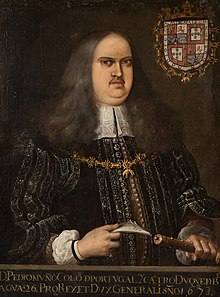Pedro Nuño Colón de Portugal, 6th Duke of Veragua
|
Don Pedro Nuño Colón de Portugal Duque de Veragua Caballero del Toisón de Oro |
|
|---|---|
 |
|
| Viceroy of New Spain | |
|
In office December 3, 1673 – December 8, 1673 |
|
| Monarch | Charles II |
| Preceded by | Antonio Sebastián de Toledo, 2nd Marquis of Mancera |
| Succeeded by | Payo Enríquez de Rivera |
| Personal details | |
| Born | 1615 Madrid, Spain |
| Died | December 8, 1673 (aged 44) Mexico City, New Spain |
| Spouse(s) | Isabel de la Cueva y Enriquez de Cabrera |
| Religion | Catholic |
Pedro Nuño Colón de Portugal y Castro, (Madrid, Spain, 13 December 1628 – December 8, 1673, Mexico City) was viceroy of New Spain from December 8, 1673 to December 13, 1673. He was 6th Duke of Veragua, 6th Marquis of Jamaica and 6th Count of Gelves (in full, Don Pedro Nuño Colón de Portugal y Castro, Duque de Veragua, Marqués de la Jamaica y de Villamizar, y Conde de los Gelves).
Colón de Portugal was a direct descendant of Christopher Columbus and a knight of Order of the Golden Fleece, 1670. He also held the positions of admiral and governor of the Indies. He was the first viceroy of New Spain named under the authority of King Charles II. His term was the shortest of all the viceroys'. He died five days after formally taking up the position.
On April 28, 1672, Enrique de Toledo y Osorio, Marquis of Villafranca was named viceroy of New Spain, but he declined the post.
Colón de Portugal was named viceroy on June 10, 1672, and he arrived in Veracruz in September 1673. He delayed some time in Veracruz to look over the fortifications there. Spain was now at war with France.
He arrived at Chapultepec November 16, 1673, and remained there three weeks for reasons of health before making his entry into Mexico City. He took possession of the government the night of November 20, but delayed exercising the functions of government. He finally made his solemn entry into Mexico City on December 8, 1673, and he died on December 13. His government is dated from December 8, rather than November 20.
One of his few official acts was to lower the prices of cacao and maize.
He died at 5 in the morning. His funeral was conducted with great solemnity in the cathedral, where his remains were deposited in the chapel of Santo Cristo. Some historians claim that his remains were later moved to Spain, but others claim they are still in the cathedral.
The day of his death Inquisitor Juan de Ortega delivered sealed instructions to the Audiencia that in the event of the death of Pedro Nuño Colón de Portugal, the government was to be transferred to Payo Enríquez de Rivera, archbishop of Mexico.
...
Wikipedia
